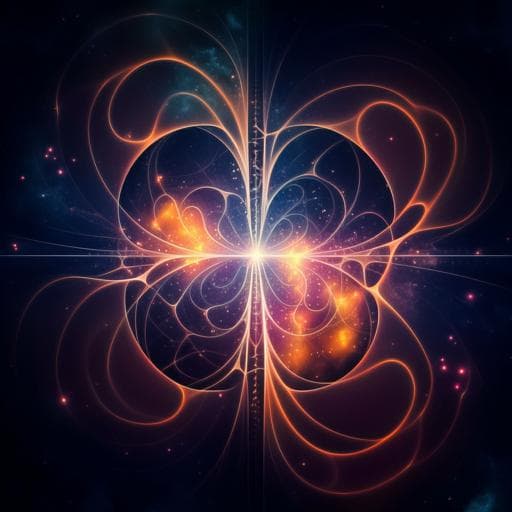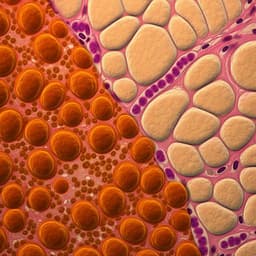
Physics
Entanglement-enhanced matter-wave interferometry in a high-finesse cavity
G. P. Greve, C. Luo, et al.
Discover groundbreaking advancements in matter-wave interferometry as Graham P. Greve, Chengyi Luo, Baochen Wu, and James K. Thompson demonstrate the use of 700 entangled atoms, achieving unprecedented sensitivity below the standard quantum limit! This innovative research opens doors to potential applications in enhanced inertial sensors and beyond.
~3 min • Beginner • English
Introduction
Light-pulse matter-wave interferometers use quantized momentum kicks from two-photon transitions to split, redirect and recombine atomic wave packets so that two quantum trajectories interfere. The phase encoded between these paths carries the signal of interest but is fundamentally limited by quantum projection noise, yielding the standard quantum limit (SQL) in phase estimation scaling as 1/sqrt(N). The research question is whether entanglement between atoms’ external (momentum) degrees of freedom inside a high-finesse optical cavity can reduce interferometric phase noise below the SQL and be injected into a practical Mach–Zehnder sequence. The study demonstrates a cavity-QED matter-wave interferometer with directly observed sub-SQL phase noise, uniting delocalized particle superpositions with many-particle entanglement and opening avenues for quantum-enhanced sensing and many-body physics.
Literature Review
Prior work has achieved entanglement among atoms via collisional and Coulomb interactions, including number squeezing between spatially separated modes and internal-state spin squeezing in cavities, with large amounts of entanglement demonstrated but mainly for internal states and in applications such as clocks and magnetometers. Proposals exist for applying cavity-based QND and one-axis twisting (OAT) to Bragg interferometers. Earlier interferometers operated in low-finesse cavities primarily for optical mode control rather than for strong collective coupling. This work advances by realizing strong collective atom–cavity coupling and generating entanglement directly in momentum states suitable for injection into a light-pulse interferometer.
Methodology
Experimental platform: A vertical two-mirror high-finesse optical cavity (F = 1.3 × 10^5, waist w = 72 μm) at 780 nm provides strong collective coupling N·C ≈ 500. The cavity power decay rate is κ = 2π × 56(3) kHz, mirror separation L = 2.2 cm, and free spectral range ω_FSR = 2π × 6.7879 GHz. Ultracold 87Rb atoms are laser cooled inside the cavity, then undergo guided free fall along z using a blue-detuned hollow optical dipole guide, yielding a transverse r.m.s. cloud radius r_rms = 4.7(8) μm.
Matter-wave control: Velocity-sensitive two-photon Raman transitions at λ = 780 nm impart 2ħk momentum kicks. Clock states |↓⟩ = |F=1, mF=0⟩ and |↑⟩ = |F=2, mF=0⟩ (split by ω_HF = 2π × 6.835 GHz) are driven by tones derived from a laser stabilized between adjacent cavity TEM00 modes with sidebands detuned ±23 MHz from resonance when 2ω_R = ω_HF, enabling Raman Rabi frequency Ω_two-photon ≈ 2π × 10 kHz while suppressing laser frequency noise coupling. The sideband frequency difference is ramped at 25 kHz ms^−1 to compensate gravitational acceleration.
Velocity selection: The axial velocity distribution is mapped via velocity-dependent spin flips after a fall time, and a narrow group is selected using Ω_two-photon ≈ 2π × 1.4 kHz to prepare N0 ≈ 800–1,200 atoms in a narrow momentum distribution with r.m.s. Δp ≈ 0.1 ħk. Discrete momentum superpositions (e.g., |0 ħk⟩ and |4 ħk⟩) are generated and verified spectroscopically. Intracavity Bragg transitions connect |n ħk⟩ ↔ |(n+2) ħk⟩ without changing spin, enabling momentum separations up to 10 ħk.
QND squeezing: A TEM00 probe is tuned δc = ωc − ωa to the blue of |↑⟩ → |e⟩, yielding an effective QND Hamiltonian HQND = ħ (ĉ† + ĉ) χ_QND N_↑ after adiabatic elimination of |e⟩. The cavity resonance shift per atom in |↑⟩ is χ_QND = 2π × 335(4) Hz at δc = 2π × 175 MHz. Population N_↑ is estimated by sweeping the probe frequency across resonance and detecting the reflected field’s Q quadrature with homodyne detection; N_↓ is measured after a Raman π pulse that swaps populations and cancels probe light shifts. A pre-measurement with M probe photons localizes the collective spin projection Jz below the coherent state level; a subsequent final measurement reads out the state. Bloch vector length |J| is obtained from the fringe amplitude of Jf versus the azimuthal phase of a π/2 pulse inserted between measurements; the initial |J|i is measured similarly without the pre-measurement. The spectroscopic enhancement W is determined versus M, balancing vacuum noise at low M and free-space scattering-induced decoherence and Bloch vector shortening at high M.
OAT squeezing: Cavity-mediated interactions implement unitary one-axis twisting with effective Hamiltonian HOAT = ħ χ_OAT Jz^2 by applying a fixed-frequency drive detuned from the dressed cavity resonance by δ ≳ κ/2. Population-dependent tuning of the cavity transmission makes intracavity field amplitude approximately proportional to N_↓, transforming the spin–light QND term into a spin-only interaction; repeated application with an echo (τ pulse) realizes the Jz^2 nonlinearity. The resulting sheared noise distribution has its minimum variance axis rotated by a small angle α0 from z and is rotated into z for readout. Parameters for optimal OAT included M ≈ 700 probe photons, δ ≈ 2 × 350 MHz (≈ 2.7 κ/2), χ_OAT ≈ 2π × 10 Hz, and N ≈ 730 atoms.
Interferometer injection: An OAT-squeezed state is oriented via a Raman beam splitter (π/2 + α0) to align the squeezed quadrature along y for phase sensing. A Mach–Zehnder sequence is executed: free evolution Tevol, Raman π mirror, free evolution Tevol, and a final π/2 readout pulse. The momentum–spin population difference Jf is measured destructively, and contrasts |J|i and |J|f are obtained by scanning the azimuthal phase of the final π/2 pulse to extract fringe amplitudes. Interferometer contrast C ≈ 2|J|/N0 ≈ 0.9 in unsqueezed operation.
Key Findings
- Demonstrated entanglement between atoms’ external momentum states inside a high-finesse cavity and injected it into a Mach–Zehnder matter-wave interferometer.
- QND-based squeezing achieved directly observed spectroscopic enhancement W = 0.46(11), corresponding to 3.4 ± 1.1 dB below the SQL, at M ≈ 600 probe photons, N = 1,170(30) atoms, and δc = 2π × 175 MHz.
- OAT-based squeezing achieved W = 0.56(8), corresponding to 2.5 ± 0.6 dB below the SQL, with M ≈ 700 photons, δ ≈ 2 × 350 MHz (≈ 2.7 κ/2), χ_OAT ≈ 2π × 10 Hz, and N = 730(10) atoms.
- Injecting OAT-squeezed states into a Mach–Zehnder interferometer yielded directly observed phase sensitivity 1.7 ± 0.3 dB beyond the SQL with N = 660(15) atoms and Tevol = 0.112 ms; compared to the unsqueezed interferometer in the same apparatus, the phase variance improved by 3.4 ± 0.2 dB.
- Matter-wave control within the high-finesse cavity included Raman-driven superpositions (e.g., |0 ħk⟩ and |4 ħk⟩) and Bragg momentum splitting up to 10 ħk.
- Entanglement persisted over wave-packet separations exceeding 12 μm and sub-SQL sensitivity was maintained for squeezed interferometry up to Tevol ≈ 0.7 ms; squeezing in the population basis persisted beyond 1 ms when left aligned with Jz.
- Achieved strong collective coupling N·C ≈ 500 in a cavity with κ = 2π × 56(3) kHz, F = 1.3 × 10^5, w = 72 μm, L = 2.2 cm, ω_FSR = 2π × 6.7879 GHz.
Discussion
The work demonstrates that cavity-generated entanglement of external momentum states can enhance the phase sensitivity of a light-pulse matter-wave interferometer beyond the standard quantum limit. By employing both QND measurements and unitary OAT interactions under strong collective atom–cavity coupling, the experiment reduces quantum projection noise in the relevant spin–momentum projection and successfully transfers this advantage into a Mach–Zehnder sequence. The below-SQL sensitivity confirms that entanglement among atoms’ motional states is a practical quantum resource for precision interferometry. Limitations to the interrogation time likely arise from spin-related decoherence or technical rotation noise, as indicated by comparable behavior when substituting microwave pulses for optical Raman pulses and by improved longevity when the squeezed axis is left in the population basis. The results open pathways to quantum-enhanced inertial sensing, tests of fundamental physics, and future advanced gravitational wave detection schemes using atom interferometers. Improvements are anticipated via larger momentum transfer sequences (e.g., Bragg LMT), probing on cycling transitions to increase quantum efficiency, higher collective cooperativity, better axial cooling or use of BECs to increase atom number while maintaining narrow momentum width, and techniques to suppress or common-mode technical rotation noise for large atom numbers.
Conclusion
This study realizes a proof-of-principle entanglement-enhanced, cavity-based matter-wave interferometer. Entanglement is generated between atoms’ external momentum states via cavity QND measurements and OAT interactions, with directly observed squeezing as large as 3.4 dB (QND) and 2.5 dB (OAT) below the SQL. Critically, OAT-squeezed states were injected into a Mach–Zehnder interferometer to achieve 1.7 dB sub-SQL phase sensitivity. The combination of high-finesse cavity control, Raman/Bragg momentum manipulation, and persistent entanglement across separated wave packets lays a foundation for next-generation quantum sensors with improved precision, bandwidth, accuracy, and compactness. Future research directions include integrating larger momentum transfer, operating with cycling-transition probes to boost quantum efficiency, mapping spin squeezing onto pure momentum states, increasing atom number and cooperativity, and mitigating classical rotation-added noise to scale sensitivity gains.
Limitations
- Sub-SQL interferometric sensitivity persisted only up to Tevol ≈ 0.7 ms; beyond this, performance degraded, likely due to spin-related decoherence or technical rotation noise during Raman operations.
- Unsqueezed interferometer performance was worse than the SQL due to imperfect contrast (C ≈ 0.9), impacting the baseline for comparison.
- QND-squeezed states were not successfully used in the interferometer; free-space scattering and limited total effective quantum efficiency (q ≈ 0.1) reduced Bloch vector length and decorrelated pre- and final measurements at higher probe photon numbers.
- Velocity selection constrained the final atom number (≈ 700–1,200), limiting absolute SQL scaling; higher momentum-space density via improved axial cooling or BEC would help.
- Classical rotation-added noise during Raman/Bragg pulses becomes significant as atom number increases; mitigation or common-mode rejection will be necessary for scaling.
- Free-space scattering at high probe powers shortens |J| and induces transitions to other ground states, limiting achievable QND squeezing.
Related Publications
Explore these studies to deepen your understanding of the subject.







